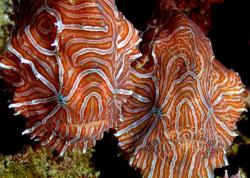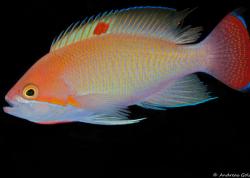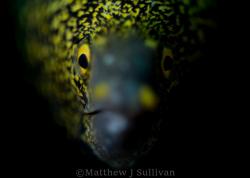Rainbow parrotfish (Scarus guacamaia).
Betsy with hawksbill turtle.
There are two parts to Tormentos, separated by a single, large sand dune. Tormentos gets deeper towards the end, so this is a good dive for nitrox. There are nice windows in the coral heads and many, colorful fish.
Margates (Haemulon album).
Queen angelfish (Holocanthus ciliaris). Why do some fish display such vivid colors? Sexual attraction? In any case, this one is a real beauty.
Betsy and I went to see El Presidente, the big barracuda that hangs out under the pier. While I burned pixels, Betsy worked her way up the iron shore looking for jawfish. The barracuda was very patient but wouldn't let me get too close to it. There's an artificial reef offshore made up of the old pier that was destroyed by hurricane Wilma; the gate from the hotel makes a nice backdrop for a school of grunts.
"El Presidente" – Great barracuda (Sphyraena barracuda).
School of grunts & iron gate (Haemulon sp).
Day Four – Scuba II with Jesús, et al
Palancar Gardens
WOW! What a wonderful dive. The magnificence of Palancar Gardens defies verbal description. Huge coral heads, the size of apartment houses, are covered in colorful sponges. A large school of baitfish hugged the wall while being watched by black groupers ready for lunch. There was almost no current on this dive and visibility was off the chart.
Black grouper and bait (Mycteroperca bonaci). This is my favorite picture of the trip!
Lesser electric ray (Narcine brasiliensis). Don't touch! Shocking.
Yocab Reef
A shallow reef, Yocab is home to many colorful fish. A huge grouper hung under the reef and allowed me to get up close and personal. It rained while we were doing our safety stop, but the sun came out on the way back to SCC.
Black grouper (Mycteroperca bonaci).
Red hind (Epinephelus guttatus).
Shore
I put my 50mm macro lens on the camera and went out to play with the small stuff in front of the hotel.
"Yawn." Bluestriped grunt (Maemulon sciurus). Timing is everything.
Day Five – Scuba II with Jesús et al
Santa Rosa Wall
SR is always a crowd pleaser. The wall approaches vertical and there's structure on the top. At the end of the reef, you can cross the sand to another low lying reef with scattered coral heads and sponges. Large groupers were out in force on the wall and a very unconcerned turtle posed for the photographers at the end of the dive.

Yellowfin grouper (Mycteroperca venenosa).

Hawksbill (Eretmoshelys imbriocata). "Haven't I seen you here before?"
Villablanca (dive of the seven cables)
We only saw one of the seven cables on this dive. We spent a great deal of time looking for seahorses – found two, a yellow one and an orange one. As an added bonus, a large, green moray eel was hiding in a hole on the top of the reef.

Seahorse (peekaboo) (Hippocampus reidi).

Yellow seahorse.
Shore
We visited the artificial reef in front of the hotel to shoot fish faces and poke around looking for small stuff.

Roughhead blenny in worm shell (Acanthemblemaria aspera).
Day Six – Scuba II with Jesús et al. plus Dave and Mike

Colombia Deep
Spectacular coral buttresses the size of apartment houses line the drop off. We started the dive on the southernmost pinnacle and traversed the sand gap to reach the rest of the reef. When we started to run out of bottom time, we moved up to the shallower reef to extend our time. A couple of southern stingrays were hunting in the sand along with a shadowing bar jack and a permit. A small turtle teased us on our safety stop, swimming slowly beneath us as we hung at fifteen feet.

Jesús with lionfish (Pterois volitans).
Colombia Shallows
Located inshore from Colombia Reef, the Shallows is a large, shallow area where large schools of snappers and grunts hang out between coral heads. Mike found a shark sleeping under the reef, but its head was inside the reef and I didn't go for a butt shot. A pair of turtles was feeding on the sand off the reef, as well as a pair of terminal male rainbow parrotfish (no, I wasn't able to get close enough to them for a photograph.) This was Chris and Walt's last dive of the week. I hope to see you next year!

School of Caesar grunts (Haemulon cabonarium) on Colombia. One fish just can't help but head the wrong way.

Mixed school of grunts on Colombia Shallows.

Another hawksbill. I never get tired of seeing turtles on the reef.
Shore
Betsy demonstrates technique and gets the shot. After seeing my "yawn" picture from before, she got a great image with three fish yawning at the same time. I'm green with envy.
Day Seven – Coral Diver with Ariel. Ed joined us after the departure of Chris/Walt
La Francesa
The northern end of Palancar Reef is called "the French lady" or La Francesa. Here, the reef is moderately high, but has no associated wall. On the open water side of the reef are great overhangs to search under for crabs, lobsters, groupers, etc. Ariel killed a couple of invasive lionfish and fed their carcasses to a splendid toadfish. A nice hawksbill turtle let me take its portrait. At one point I looked up and a free swimming green moray was up close and personal with Deborah. At that point the eel decided it liked my fins and smelled along the edges before swimming off, down the reef.

Green moray sniffing my fin. "Please don't bite me!"
El Paso de Cedral
The best place on the reef to see porkfish and often home to many groupers, Cedral is a short reef with a wonderful tunnel system under the reef that's fun to explore. After the end of the reef, we drifted over to Santa Rosa shallows.

Porkfish school (Anisotremus virginicus). Tastes like chicken?
Day Eight – Scuba II with Jesús, Mel, Juanita, Dave, Mike, George, Deborah and me
Bolones de Chankanaab
Bolones is offshore from Chankanaab Reef and consists of a sandy bottom interspersed with large coral heads. We were greeted by several large groupers that have learned that the dive guides will often kill lionfish and offer them to the large fish.

Deborah and grouper.

Splendid toadfish (Sanopus splendidus) and busy body fish. "What cha doing? Taking a picture of the toadfish? How about me? Won't you take my picture, too?"
Chankanaab Reef
There are lots of large lobsters, big crabs, and many colorful fish on this reef. The current usually runs to the south due to an eddy created by the shoreline. This is a great dive site to find the endemic, splendid toadfish.

Splendid toadfish (Sanopus splendidus).
Shore
Last August, John found a yellow frogfish on a shore dive. Common elsewhere, it's rare to see any frogfish in Cozumel. We were able to locate the yellow frogfish on subsequent dives, but it was gone when we returned to the island two months later. Yesterday, on this trip, Betsy reported that she had found the elusive fish and offered to take us back to the spot where it was last seen. Upon arriving, we discovered the fish had moved. After a couple of minutes, Betsy spotted the frogfish doing its best imitation of a sponge, flat up against the side of a rock. Returning to the artificial reef in front of the hotel, Deborah found a Spanish lobster.

Longlur frogfish (Antennarius multiocellatus).
Day Nine – Scuba II with Jesús et al
Palancar Caves
There aren't any "caves" at this dive site, instead there are large passages through the coral heads with many exits and openings. The structure along the edge of the wall is fantastic, huge and colorful. We saw a turtle feeding many feet below our maximum depth, so I didn't get to take its picture. After the main reef, we moved up and across the sand to a shallow reef area and poked around until the end of the dive. A large barracuda was being cleaned by a juvenile Spanish hogfish and allowed me to get within strobe range.
Jesús, sponge and baitfish. I really like this picture! I think it's the curve of the baitfish over the sponge that gives it punch.
Las Palmas
Near the Fiesta American hotel, the current splits, with one part going south towards Chankanaab and the other part heading north. We dropped in on the north current and were blown in that direction and had to swim to stay on the drop off. There were schools of small bar jacks, feeding in the current and other fish, but it was almost impossible to stop and take pictures, the current was so strong. We swam over a large sandy area to get to the inshore side of Paradise where we looked, unsuccessfully for seahorses.
Shore
Betsy had signed up for the twilight/night boat and Deborah was resting, so I did an afternoon dive with Margaret.
Goldentail moray (Gymnothorax miliaris).
Lionfish (Pterois volitans). An invasive species that is threatening the reef ecology in the Carribean.
Day Ten – Scuba II with Jesús. My sister, Jana, and brother-in-law, Mike, joined us today!
Paso de Cedral Drop Off
Offshore from Paso de Cedral Reef, the drop off is a wild, current ride on top of the drop off into the deep blue. This is a great place to see turtles, sharks, large parrotfish, and many colorful fish. Unfortunately, I had failed to notice a smudge on the inside of my lens port and most of my pictures from today's dives aren't worth sharing. Part way through the dive, we moved over to Paso de Cedral Reef and made two dives out of one.
Paso de Cedral
We had so much fun on the first dive, we voted to repeat the reef!
Channel clinging crab (Mitrax spinosissimus).
Shore
Deborah, Betsy, George, and I went a long way along the ironshore in search of the frogfish. It had moved from its last position, but Betsy found it again after some close inspection of the wall. On the way back, I spotted a needlefish just under the surface.
Houndfish (Tylosurus crocodilus).
Curved trumpet fish, ready to strike.
Day Eleven – Scuba II with Jesús et al
La Francesa
Today was Mike and Dave's last day, so we opted for a couple of shallower dives. This was our second visit to the "French Lady" on this vacation. On the first part of the reef is a tunnel that runs much of the length of the coral head. While there isn't much to see in the swim through, sunlight penetrating the reef gives the tunnel a religious aspect that's hard to describe and hard to photograph! We saw the big three, turtle, green moray, and nurse shark.
Green moray.
Nurse shark (Gingliomostoma cirratum) & shark sucker (Echeneis naucrates).
Paradise Reef
A good selection for Dave/Mike's last dive, Paradise offered a long, slow drift with lots of time to poke around and look for small stuff.
Patterns on a coral head.
Day twelve – Scuba II with Jesús, Jana, Mike, Deborah, Mel, Juanita, Betsy, George
Colombia Bricks
Another fabulous dive on the Colombia/Palancar reef system. A slow drift through the huge coral structures at the top of the drop off before moving up to the top of the reef to extend our bottom time. We saw only one turtle on this dive, very unusual for this dive site. I played with wide angle photography and my favorite yellow sponges.
Bluestriped grunt (Haemulon sciurus) eating a brittle star – Predation on the reef is hard to capture with a camera; either the action is too fast or too infrequent. This snapper had just grabbed a brittle star and was having a hard time getting it down!
Yocab
This dive was a repeat of one we did the previous week. The huge grouper was still under the overhang about half way down the reef.
Black grouper (Myctoperca bonaci) showing off one of its color changes.
Shore
I put my macro lens on the camera and went to look for small stuff. There's a lot to see on a shore dive if you look closely.
Orangeclaw hermit crab (Calcinus tibicen).
Juvenile smooth trunkfish (Lactophrys triqueter) (50 mm Zuiko lens with SubSee 10X diopter).
Day Thirteen – Scuba II with Jesús
Bolones de Chankanaab
This was Mel and Juanita's last day of diving and they requested a return to Bolones. There were fewer groupers on this dive than there were last week, but lots of other colorful fish to keep everyone happy. There's a brown looking sponge on Bolones that turns a bright red-orange under
strobe light, making for some nice wide angle shots that attempt to show what the reef looks like.
Erect ropesponge (Amphimedon compressa).
Chankanaab Reef
After a short surface interval, we dove on the normal Chankanaab Reef. A barracuda was being cleaned by some neon gobies and was not going to back away from the photographers. Too soon, we had to end our dive and ascend for a safety stop.
Great barracuda (Sphyraena barracuda).
Shore
After a nap, I did a shore dive in front of the hotel. Highlights of this dive were an arrow shrimp pretending to be a twig and a juvenile butterflyfish.
Arrow shrimp (Tozeuma carolinense). It is head down. You can see the white eye near the bottom of the critter.
Juvenile spotfin butterflyfish (Chaetodon ocellatus).
Day Fourteen – Scuba II with Jana, Mike, Betsy, George, Deborah, Mark and Lu
Palancar Gardens
We returned to Palancar Gardens. I had hoped to find the school of baitfish that had been on the wall the previous week, but they were gone. A hogfish shadowed us as we slowly drifted down the reef. The school of jack that's been at the end of this dive for many years was still there. Several turtles delighted the divers and photographers.
Spanish hogfish (Lachnolaimus maximus).
School of horse-eye jacks (Caranx latus).
Betsy and turtle.
Tormentos

Jesús in the window. That sounds like a religious statement – "I have Jesus in my window."
Shore
Deborah and I spent a couple of hours in front of the hotel looking for small stuff.

File clam (Lima scabra). This file clam was at the same depth as the previous image where the tentacles are red. The theory is proven false.

Web burrfish (Chilomycterus antillarium).
Day Fifteen – Scuba II with Jesús et al
Santa Roda Wall
Santa Rosa is Jayne's "happy place." This dive was dedicated to her for her birthday next week. We were sorry she couldn't join us this August. After a huge group of divers passed us on the wall, we enjoyed a leisurely drift in and out of the coral formations before moving across the sand to the shallow, upper reef to extend our bottom time.
Jesús demonstrates perfect buoyancy inside the cave. "¿Donde están los otros?"
Villablanca
While Jesús paused to look for the yellow seahorse that we saw here the first week, I drifted further up the reef looking for the hole where the green moray eel was. Found it. A little turtle decided it needed to go to the surface and get some air just as we got to where it was feeding on sponges.
Diving hawksbill.
I took the afternoon off to work on this trip report and off-gas a little.
Day Sixteen – Scuba II with Jesús, Deborah, Betsy, George, Jana, Mike, Roger and Judy
Palancar Caves
We had a mild current and drifted along the wall for a while before moving up onto the shallower reef system. Only one turtle was seen and a single free swimming nurse shark was spotted in the distance. Still, a nice first dive for Roger and Judy.
Pair of balloonfish (Diodon holocanthus).
Yucab
At this point, there aren’t many reefs that we haven't visited, some more than once. The big grouper wasn't in his usual place when we got to the cut out. Instead, a large grouper was lying on the sand and let us get close. After taking a few pictures, I move over to the reef to shoot some fish schooling images. It was then that the big grouper showed up and poised with his mouth open to be cleaned by a Spanish hogfish. We were treated to a turtle encounter – can't have too many of them – at the end of the dive.
Juvenile queen angelfish (Holacanthus ciliaris).
"What kind of camera are you using?"
Day Seventeen - Jesús was sent to the mainland to take a class in Scubapro equipment repair. Scuba II with Ariel et al
San Franciso
This was a good choice for Mike's introduction to Cozumel. The drop off isn't that deep, there's some vertical structure at the top of the wall, and shallower reef at the end to extend the bottom time. We saw a nurse shark, out for a morning swim, at the beginning of the dive. Unfortunately, the one turtle on this dive was out of sight before Mike got to see it.
Paradise Reef
Ariel chose to start the dive on the flats to look for seahorses. He didn't have to look for long, he pointed out four of them! My brother-in-law discovered a juvenile seahorse, black in color. There were some very tame permits riding the current on top of the reef, but I was sticking close to my son and didn't swim up to take any pictures; call me "Dad."
Day Eighteen – Scuba II with Ariel et al
Dalila
The current was strong enough on this dive that I could not swim directly into it! We flew along, occasionally dropping behind the coral or an overhang to stop and wait for everyone. There was a green moray under a ledge and a couple of green turtles to take images of.
Lobster hotel.
Green turtle (Chelonia mydas). Green turtles are not common in Cozumel waters and are endangered by overfishing.
Ariel's Chankanaab
Ariel asked if it would be OK to dive a portion of Chankanaab that isn't normally dived. The first part of the dive consisted of a series of big coral heads that were closely spaced. This is a place to find Atlantic spadefish, but none were seen. Instead, a school of ceros tantalized this photographer by staying out of range. A large school of horseeye jacks was also too shy to get close to.
WA sponges and family.
Shore
While Deborah and Mike explored around the pier, I concentrated on some macro photography. There's a lot to see on a shore dive and a great place to play with your camera.
Odd couple. This image is strangely appealing. I think Norman Rockwell would approve.
A spotted moray being groomed by a banded coral shrimp. "A little off the top, please."
Day Nineteen – Scuba II with Jesús et al
Colombia Deep
What more can I say about Colombia Deep? Fantastic!
Colorful sponges on Colombia reef.
Colombia Shallows
Another slow drift over the shallow coral heads. Mike and I were given the close up by a small turtle.
School of grunts.
Turtle.
Shore
Night dive in front of the hotel with Mike. There was only one octopus out hunting, lots of sleeping parrotfish, and the odd eel or two.
Sleeping stoplight parrotfish (Sparisoma viride). What Larry, the cable guy, would look like if he were a fish.
Day Twenty – Scuba II with Jesús et al
Paso de Cedral
I remembered where the green moray eel was hiding a couple of weeks ago and was able to locate it for a couple of pictures before the rest of the photographers showed up. I took lots of pork fish pictures to short through later. Mike and Deborah went through the tunnel under the reef and played with a big lobster at the exit.
Porkfish. A school of porkfish has been in residence on Paso de Cedral for as long as I can remember.
Caribbean spiny lobster (Panuliris argus).
Paradise "Grass"
"Grass" is inshore of the reef at Paradise and consists of a sandy bottom with low vegetation. This is a great place to find seahorses – we saw six of the reclusive critters.
Slender filefish (Monacanthus tuckeri).
Seahorse. "Hey there, big boy, come here often?"
Too soon our vacation came to an end and we had to leave the gates of Scuba Club to head for the airport. Adios, Cozumel, regresaremos.
These are my favorite images from the trip. Which one do you think is the best? Are there any others that you like better?

Image 1 - Grouper and sliver sides.

Image 2 - Pair of squat anemone shrimp.

Image 3 - Turtle on Colombia?
Camera: Olympus E-330 in an Ikelite housing with dual Ikelite DS-125 strobes. Most images were shot with a Zuiko 14-54mm lens or a 50mm lens for macro. All images are copyrighted and may not be used without permission.






























































































 Visit Bluewater Photo & Video for all your underwater photography and video gear. Click, or call the team at (310) 633-5052 for expert advice!
Visit Bluewater Photo & Video for all your underwater photography and video gear. Click, or call the team at (310) 633-5052 for expert advice! Bluewater Travel is your full-service scuba travel agency. Let our expert advisers plan and book your next dive vacation. Run by divers, for divers.
Bluewater Travel is your full-service scuba travel agency. Let our expert advisers plan and book your next dive vacation. Run by divers, for divers.































